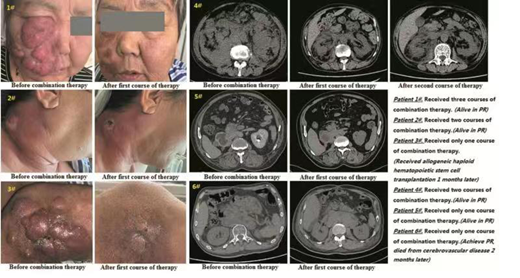Purpose: Tostudy the efficacy and side effects of programmed death 1 (PD-1) inhibitor combined with chemotherapy for refractory diffuse large B cell lymphoma (DLBCL).
Methods: Six refractory DLBCL patients with very high tumor burden or progresses rapidly disease were enrolled in a clinical trial that Toripalimab in combination with second-line chemotherapy at the Department of Hematology in Tianjin First Center Hospital (Tianjin, China). All of the eligible patients had received another clinical trial of anti-CD19 chimeric antigen receptor (CAR) modified T-cell therapy before. They had ineffective to anti-CD19 CAR-T cell therapy or had effective ever but the disease progression again. The patients were received the following combination therapy. Toripalimab (240mg) administered on day -4 and received DHAP (Cisplatin: 100mg/m2 on day 1, Cytarabine: 2g/m2q12h on day 2, Dexamethasone: 40mg/day from day 1 to 4) every 3 weeks at the same dose. Or Toripalimab administered on day 0 and received GemOx (Gemcitabine: 1000mg/m2 on day 1 and 8, Oxaliplatin: 130mg/m2 on day 1) every 3 weeks. The DNA level of anti-CD19 CAR gene in peripheral blood was detected by quantitative polymerase chain reaction (qPCR) analysis, in order to prove the PD-1 inhibitor had no combined effect with the CAR-T cells. Tumour imaging by CT or PET-CT was done at baseline, and after every course of treatment. The adverse events (AEs) were collected throughout the study and graded according to the National Cancer Institute Common Terminology Criteria for Adverse Events (Version 4.0).
Results: The median time from infusion to cutoff day was 6 months (Range: 1 to 6 months). After 2 weeks of the first course of combination treatment, all the six patients refractory DLBCL patients reached partail (PR) response of their disease. After the second or three courses of treatment, three patients kept their disease stable state for 5 months (Patient 1#), 3 months (Patient 4#) and 2 months (Patient 2#). The other three patients received only one course of treatment. One patient kept his disease stable state for 3 months (Patient 5#), one patient died from cerebrovascular disease 2 months after the combination treatment (Patient 6#). The last one patient received allogeneic haploid hematopoietic stem cell transplantation 1 months after the combination treatment (Patient 3#). No patient withdrew from the combination therapy because of treatment-related AEs. Furthermore, no treatment-related or immune-mediated deaths occurred in our study. The average proportion of anti-CD19 CAR-T cells and the mean DNA level of anti-CD19 CAR gene in peripheral blood maintained in very low levels throughout the combination therapy. It proved that the PD-1 inhibitor had no combined effect with the anti-CD19 CAR-T cells received before.
Conclusions: The PD-1 inhibitor combined with second-line chemotherapy could be as a salvage therapy for refractory DLBCL without treatment-related AEs.
No relevant conflicts of interest to declare.
Author notes
Asterisk with author names denotes non-ASH members.


This feature is available to Subscribers Only
Sign In or Create an Account Close Modal